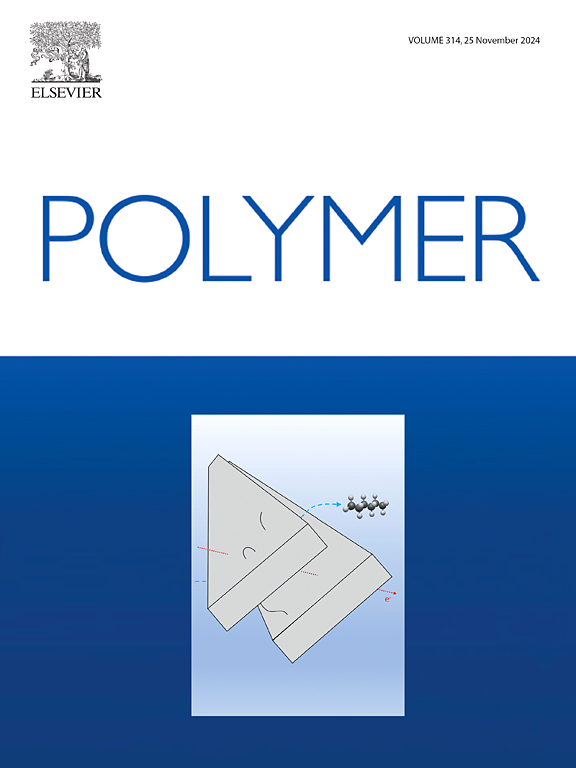Crystallization behavior of biobased poly(butylene furandicarboxylate) (PBF): Influence of amorphous chain mobility, diffusion and nucleation on thermodynamic and kinetic control
IF 4.1
2区 化学
Q2 POLYMER SCIENCE
引用次数: 0
Abstract
Isothermal and nonisothermal crystallization behavior of biobased poly(butylene 2,5-furandicarboxylate) (PBF) was studied by means of DSC, TMDSC and advanced kinetic analysis. Despite its significance for sustainable materials, several key aspects of its crystallization behavior remain poorly understood. Therefore, changes in the slope of the effective activation energy (Eα) dependencies occurring during the crystallization process are highlighted. The first change appears at the initial stage of crystallization for both heating and cooling, while the second change happens at the end of crystallization. These transitions suggest a shift in the rate-limiting step of crystallization, influenced by thermodynamic or kinetic factors. At the end of the process, the crystallization rate generally decelerates due to the reduced mobility of polymer chains, causing deviations from the Hoffman-Lauritzen (HL) theory's predictions. The present study identifies temperature-specific breaks in the effective activation energy dependencies, correlating with changes in crystallization rates at 145 °C, 137 °C, and 125 °C during cooling, and 83 °C, 87 °C, and 95 °C during heating. The rigid amorphous fraction (RAF) was found to decrease to zero around 85 °C, leading to increased polymer chain mobility and reactivation of crystallization at higher temperatures. Thus, the deviations in Eα between 83 and 86 °C align with RAF devitrification temperatures. This agreement proves that the isoconversional kinetic analysis can lead to the prediction of the temperature range of the RAF vitrification. The combination of advanced isoconversional analysis and HL rate equation accurately predicts the maximum growth rate temperature (Tmax ∼117 °C), in perfect agreement with experimental data, confirming the nonisothermal model's validity and reliability. Interpretations of the variations of Eα in terms of thermodynamic and kinetic control of the overall crystallization rate are given. 16 meaningful kinetic parameters have been optimized with success.

生物基聚呋喃二羧酸丁烯(PBF)结晶行为:非晶链迁移率、扩散和成核对热力学和动力学控制的影响
采用DSC、TMDSC和先进的动力学分析方法研究了生物基聚2,5-呋喃二羧酸丁烯(PBF)的等温和非等温结晶行为。尽管它对可持续材料具有重要意义,但其结晶行为的几个关键方面仍然知之甚少。因此,在结晶过程中发生的有效活化能(Eα)依赖关系斜率的变化是突出的。第一种变化发生在结晶初期,加热和冷却都是如此,而第二种变化发生在结晶结束时。这些转变表明结晶的限速步骤发生了变化,受到热力学或动力学因素的影响。在该过程的最后,由于聚合物链的迁移率降低,结晶速率通常会减慢,从而导致与Hoffman-Lauritzen (HL)理论预测的偏差。本研究确定了有效活化能依赖的温度特异性断裂,与冷却时145°C, 137°C和125°C以及加热时83°C, 87°C和95°C的结晶速率变化相关。刚性非晶分数(RAF)在85°C左右降低到零,导致聚合物链迁移率增加和结晶在高温下的再活化。因此,在83 ~ 86℃之间,Eα的偏差与RAF脱硝温度一致。这证明了等转换动力学分析可以预测RAF玻璃化的温度范围。结合先进的等转换分析和HL速率方程准确地预测了最大生长速率温度(Tmax ~ 117°C),与实验数据完全吻合,证实了非等温模型的有效性和可靠性。从总体结晶速率的热力学和动力学控制方面解释了Eα的变化。已成功优化了16个有意义的动力学参数。
本文章由计算机程序翻译,如有差异,请以英文原文为准。
求助全文
约1分钟内获得全文
求助全文
来源期刊

Polymer
化学-高分子科学
CiteScore
7.90
自引率
8.70%
发文量
959
审稿时长
32 days
期刊介绍:
Polymer is an interdisciplinary journal dedicated to publishing innovative and significant advances in Polymer Physics, Chemistry and Technology. We welcome submissions on polymer hybrids, nanocomposites, characterisation and self-assembly. Polymer also publishes work on the technological application of polymers in energy and optoelectronics.
The main scope is covered but not limited to the following core areas:
Polymer Materials
Nanocomposites and hybrid nanomaterials
Polymer blends, films, fibres, networks and porous materials
Physical Characterization
Characterisation, modelling and simulation* of molecular and materials properties in bulk, solution, and thin films
Polymer Engineering
Advanced multiscale processing methods
Polymer Synthesis, Modification and Self-assembly
Including designer polymer architectures, mechanisms and kinetics, and supramolecular polymerization
Technological Applications
Polymers for energy generation and storage
Polymer membranes for separation technology
Polymers for opto- and microelectronics.
 求助内容:
求助内容: 应助结果提醒方式:
应助结果提醒方式:


